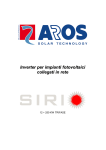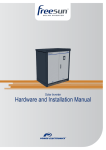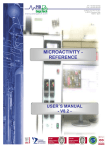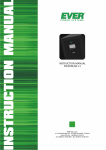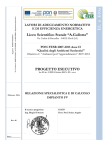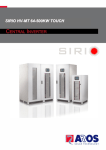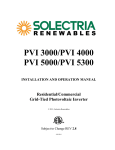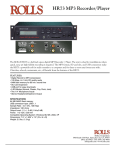Download Inverter for grid-connected photovoltaic systems
Transcript
Inverter for grid‐connected photovoltaic systems THREE‐PHASE 12 ÷ 250 KW Pg. 2/42 0MNA060D55‐GB Rev.00 User manual RPS SpA via Somalia, 20 20032 Cormano (MI) Tel. +39 02 66327.1 Fax +39 02 66327.231 www.aros-solar.com No reproduction of any part of this manual, even partial, is permitted without the manufacturer’s authorization. The manufacturer reserves the right to modify the product described herein, in order to improve it, at any time and without notice. 0MNA060D55‐GB Rev.00 pg. 3/42 Symbols used in the manual In this manual, some operations are shown by graphic symbols to alert the reader to the dangerous nature of the operations: Possibility of serious injury or substantial damage to the device, unless adequate precautionary countermeasures are taken. This symbol indicates some important information which must be read with care. It is recommended to read this part of the manual. Protective equipment to be worn No maintenance operations must be carried out on the device without wearing the Personal Protective Equipment (PPE) described below. Personnel involved in the installation or maintenance of the equipment must not wear clothes with wide sleeves or laces, belts, bracelets or other items that may be dangerous, especially if they are metallic. Long hair must be tied in such a way as to ensure that it is not a hazard. The following signs show the protective equipment that should be worn. The various items of PPE must be selected and sized according to the nature of the hazard (particularly electrical) posed by the equipment. Accident prevention footwear Use: always Protective eyewear Use: always Protective clothing Use: always Helmet Use: When there are suspended loads Work gloves Use: always Pg. 4/42 0MNA060D55‐GB Rev.00 Definition of “operator” and “specialized technician” The professional figure responsible for accessing the equipment for ordinary maintenance purposes is defined with the term operator. This definition covers personnel that know the operating and maintenance procedures for the equipment, and that have received: training to operate in accordance with the safety standards relating to the dangers that may arise where electrical voltage is present; training in the use of Personal Protective Equipment and to carry out basic first aid. The professional figure responsible for the installation and start‐up of the equipment, and for any extraordinary maintenance, is defined with the term specialized technician. This definition covers personnel that, in addition to the requirements listed above for a general operator, must also: have been suitably trained by the manufacturers or their representative. be aware of installation, assembly, repair and service procedures, and have a specific technical qualification. must have a background of technical training, or specific training relating to the procedures for the safe use and maintenance of the equipment. Emergency interventions The following information is of a general nature. First aid interventions Company regulations and traditional procedures should be followed for any first aid intervention that may be required. Firefighting measures Do not use water to put out a fire, but only fire extinguishers that are suitable for use with electrical and electronic equipment. If exposed to heat or fire, some products may release toxic fumes into the atmosphere. Always use a respirator when extinguishing a fire. 0MNA060D55‐GB Rev.00 pg. 5/42 ENVIRONMENTAL PROTECTION In the development of its products, the company devotes abundant resources to analysing the environmental aspects. All our products pursue the objectives defined in the environmental management system developed by the company in compliance with applicable standards. No hazardous materials such as CFCs, HCFCs or asbestos are used in this product. When evaluating packaging, the choice of material has been made favouring recyclable materials. For correct disposal, please separate and identify the type of material of which the packaging is made in the table below. Dispose of all material in compliance with applicable standards in the country in which the product is used. DESCRIPTION MATERIAL Box Cardboard Packaging corner Stratocell Protective bag Polythene Accessories bag Polythene DISPOSING OF THE PRODUCT The UPS and the Battery Box contain electronic cards and batteries which are considered TOXIC and HAZARDOUS waste. When the product reaches the end of its operating life, dispose of it in accordance with applicable local legislation. Disposing of the product correctly contributes to respecting the environment and personal health. Pg. 6/42 0MNA060D55‐GB Rev.00 Thank you for choosing our product. Aros Solar Technology is highly specialized in the development and production of equipment for static energy conversion. The inverters of the three‐phase SIRIO series are high quality products, carefully designed and manufactured to ensure optimum performance. GENERAL PRECAUTIONS This manual contains instructions for the use, installation and start‐up of SIRIO inverters. Read the manual carefully before installation. The manual should be kept close at hand and consulted for information on using the equipment before carrying out any operation. • The first connection to be made is the connection between the earth conductor and the terminal with the symbol shown here: • The inverter must not operate without an earth connection. • The device must be installed and used in compliance with the instructions set out in this text and with the procedures that may be suggested from time to time.. • The operating and maintenance personnel and specialized technicians should be adequately trained in the safe use and maintenance of the device. They should always operate with due precaution and wear personal protective equipment (PPE). • Maintenance must not be carried it inside the inverter when it is being powered from the mains or the DC voltage. For maintenance switch the inverter off and open all the other switches. Always use a multimeter to ensure that there are no dangerous voltages. • There are dangerous voltages inside the equipment even when the input and output switches are in the open position; trained personnel must wait around ten minutes for the capacitors to discharge before working on the inside of the inverter. • The specialized technician must comply scrupulously with the following instructions for the installation and maintenance of the inverter: • use insulated tools. • observe polarities. • if the fuses need replacing, replace only with the same type. • the replaced components must be disposed of in accordance with the legislation in force in the country of installation. • Do not deactivate the protection devices or ignore the warnings, precautions and alarms described in this manual or those shown on data plates on the equipment. • Promptly replace any danger signals if they should become illegible through usage. • The inverter must be used only with all side and internal panels duly secured and with the front door closed. • Under no circumstances may the structure of the equipment, the devices mounted on it, the operating sequence, etc. be modified, tampered with or altered in any way without first consulting the manufacturers. • All ordinary and extraordinary maintenance operations must be noted in the appropriate register with the date, time, type of intervention, operator name and any other useful information. 0MNA060D55‐GB Rev.00 pg. 7/42 • Once the maintenance operations have been concluded, a thorough check should be made in order to ensure that no tools and/or other materials have been left inside the cabinet. • In the event of faults or malfunctions, contact your local distributor or Aros. All repair operations must be carried out by authorized technicians. • Under no circumstances must water be used to clean the internal or external electrical parts of the cabinet. • Do not leave the device exposed to rain or to the elements. The device must be stored and used in premises that comply with the environmental requirements set out in this user manual. Instructions for use The purchased equipment is intended for professional use in industrial or commercial environments. Shielded cables must be used for the connections to signalling connectors. Warning Sale of this product is reserved for competent installers. Installation restrictions or additional measures may be necessary in order to avoid problems. CE Mark The inverters of the SIRIO series come with CE marking; when used in accordance with the instructions in this manual, they comply with the requirements of the following directives: ‐ LV Directive 2006/95/EC. ‐ EMC Directive 2004/108/EC. No reproduction of any part of this manual, even partial, is permitted without the manufacturer’s authorization. The manufacturer reserves the right to modify the product described herein, in order to improve it, at any time and without notice. Pg. 8/42 0MNA060D55‐GB Rev.00 Summary INTRODUCTION ..................................................................................................................................... 10 STORAGE .............................................................................................................................................. 12 INSTALLATION ENVIRONMENT .............................................................................................................. 12 PRELIMINARY OPERATIONS .................................................................................................................. 12 CHECKING THE PACKAGING................................................................................................................................ 12 POSITIONING ........................................................................................................................................ 13 ELECTRICAL SYSTEM SETTINGS .............................................................................................................. 14 SYSTEM PROTECTION........................................................................................................................................ 14 PHOTOVOLTAIC FIELD / NETWORK CONNECTIONS .................................................................................................. 14 CONNECTORS FOR REMOTE COMMANDS, SIGNALLING AND COMMUNICATIONS .......................................................... 17 CHECK CONNECTIONS ....................................................................................................................................... 21 START‐UP PROCEDURE .......................................................................................................................... 21 FUNCTIONAL CHECK .............................................................................................................................. 21 SHUTDOWN .......................................................................................................................................... 22 PERSONALIZATIONS .............................................................................................................................. 22 OPERATION ........................................................................................................................................... 22 MAINTENANCE...................................................................................................................................... 23 GENERAL CHARACTERISTICS .................................................................................................................. 25 GENERAL CHARACTERISTICS HV VERSION ............................................................................................. 29 INVERTER USER PANEL FUNCTIONS. ...................................................................................................... 32 GENERAL DESCRIPTION. .................................................................................................................................... 32 SIGNAL MESSAGES: .......................................................................................................................................... 32 ALARM MESSAGES ........................................................................................................................................... 33 COMMAND PANEL MENUS.................................................................................................................... 35 NORMAL OR BASIC MENU. ............................................................................................................................ 35 MENU KEYS 1, 1: LANGUAGES. ...................................................................................................................... 35 MENU KEYS 2: MEASUREMENTS .................................................................................................................... 36 MENU KEYS 2,6: TIME MEASUREMENT. ........................................................................................................ 36 MENU KEY 3 "KEY", COMMANDS. .................................................................................................................. 37 MENU KEYS 3, 5 : PERSONALIZATIONS........................................................................................................... 37 MENU KEYS 3, 5, 4 : PERSONALIZ. MODEM.................................................................................................... 37 MENU KEYS 3, 5, 4, 4, (5/6) : PERSONALIZ. "DIAL /SEND" MODEM .................................................................... 38 MENU KEYS 3, 5, 5 : PERSONALIZ. RS232. ...................................................................................................... 39 MENU KEYS 3, 5, 6: MPPT MODES ................................................................................................................. 39 MENU KEYS 3, 5, 7: PERSONALIZ. IDENT. ....................................................................................................... 39 MENU KEYS 3, 7 : INVERTER‐OFF ................................................................................................................... 39 MENU KEY 4 "RECORDER": RECORDED EVENTS................................................................................................ 40 MENU KEYS 4, 2 + 2: MEASUREMENT OF RECORDED VOLTAGES. ................................................................. 40 MENU KEY 4, 6: RECORDED CODES................................................................................................................ 40 MENU KEY 5: SILENCING THE ACOUSTIC ALARM. ................................................................................................... 41 MENU KEY 6, "CLOCK": DATE/TIME. ................................................................................................................ 41 MENU KEY 7 "LOWER ARROW": INTERNAL CODES. ........................................................................................... 42 0MNA060D55‐GB Rev.00 pg. 9/42 INTRODUCTION This document describes the features of the Three‐phase Solar Converters of the SIRIO series with isolation transformer. The SIRIO inverter is used to transfer the energy produced by a photovoltaic generator to the three‐phase power distribution system. The MPPT (Maximum Power Point Tracking) feature ensures that the power is drawn from the photovoltaic modules with the operating point continuously optimized in relation to the irradiation conditions, the characteristics of the panels, their temperature and the converter characteristics. The system is designed to allow it to feed into the network a current with a sinusoidal waveform and uniform power factor in all operating conditions. The interface between the device and the network has a low frequency, three‐phase isolation transformer. This satisfies current legislation and also prevents the injection of continuous current components into the distribution grid. Having such a component also helps protect the inverter in the event of overvoltages on the electrical system. The operating parameters and electrical values can be displayed locally, by means of the alphanumeric LCD display with 2x40 characters, and remotely by means of monitoring systems. The functions listed above are obtained by means of power electronic architecture of the PWM (Pulse Width Modulation) type using semiconductors of the IGBT (Insulated Gate Bipolar Transistor) type and a microprocessor‐based control logic which can carry out all the required processing in real time. The figure below shows the inverter block diagram: Three phase LF CONTACTOR MAINS AC SWITCH EMC Filter AC Filter EMC Filter DC SWITCH PV ARRAY f Control S Local & Remote Pg. 10/42 0MNA060D55‐GB Rev.00 • EMC filters: these are used to reduce conducted radiofrequency emissions on both the photovoltaic modules and on the AC network • Inverter: this is the section in which the energy from the photovoltaic modules is converted from direct current into alternating current. • LF transformer: this has a dual function; it ensures the galvanic separation of the direct current section from the alternating current section and increases the voltage generated by the inverter up to the rated output value • AC filter: its function is to recreate a sinusoidal current waveform by eliminating the high frequencies generated by the inverter stage. • Contactor: separates the inverter from the AC network during periods of non‐operation, thus eliminating transformer no‐load losses. • DC disconnector: disconnects the photovoltaic field from the inverter to allow maintenance to be carried out on the inverter • AC disconnect switch: disconnects the inverter from the AC network in the event of maintenance and is triggered to protect the network in the event of an internal fault in the AC section of the device • Control system: this is the heart of the entire system that manages all parts of the equipment. • Communications: for local monitoring (display + keyboard) of inverter operation or remote monitoring by means of appropriate electrical connections. 0MNA060D55‐GB Rev.00 pg. 11/42 STORAGE If the inverter is not installed immediately, it should be stored with its original packaging and protected from humidity and the elements. The storage premises should comply with the following characteristics: Temperature: Relative humidity ‐25°C ÷ + 60°C (‐13°F ÷ 140°F) 95% max Recommended storage temperature is between +5°C and +40°C. INSTALLATION ENVIRONMENT The equipment has been designed for indoor installation. The choice of premises for installation should comply with the points set out below: avoid dusty environments; ensure that the floor can support the weight of the inverter; avoid narrow environments that could hinder normal maintenance operations; avoid placing the device in areas exposed to direct sunlight or heat; ensure that the ambient temperature, with inverter operating, is less than: operating temperature: maximum temperature for 8 hours a day: average temperature for 24 hours: 0 ÷ +45°C + 45°C + 35°C N.B.: the operating temperature recommended for the lifetime of the inverter is between 10°C and 35°C. A heat dissipation system is required to keep the temperature in the installation site within this field (the value of the power dissipated by the inverter is shown in the section “GENERAL CHARACTERISTICS). PRELIMINARY OPERATIONS Checking the packaging ‐ Upon receipt of the inverter, check that the packaging has not been damaged during shipping. ‐ Check that neither of the two impact resistant devices on the packaging has turned red; if one of them should be red, follow the instructions on the packaging. ‐ Care should be taken when removing the packaging in order to avoid scratching the inverter cabinet. ‐ The device must be handled with care; it may be damaged if knocked or dropped. ‐ This technical user manual is supplied with the inverter. The device should only be handled by appropriately trained personnel. It can be unloaded from the vehicle and put into place by lifting the box or the wooden deck to which the equipment is secured with a fork‐lift truck. A transpallet or fork‐lift truck should be used for the permanent positioning of the equipment, in accordance with the instructions provided below. Pg. 12/42 0MNA060D55‐GB Rev.00 1) Insert the forks of the fork-lift truck in the lower part of the device, from the front or back, and ensure that they stick out about 30 cm on the other side. If a transpallet is used, raise the device only as much as is strictly necessary. 2) Secure the device to the transpallet or fork-lift before moving it. Risk of overturning In order to avoid the risk of the device overturning, ensure that it is firmly secured to the transpallet or fork‐lift truck by means of appropriate ropes before moving it. The cabinet should be handled with care during these operations, since knocks or drops can damage it. Once in position, remove the packaging carefully so as not to scratch the device. The packaging should be removed as follows: 1) 2) 3) 4) Cut the bands Carefully remove the cardboard packaging from above. Remove the screws securing the cabinet to the wooden base. If using a transpallet, remove the device from the pallet and place it on the floor, using the same precautions as set out in the section on Handling. POSITIONING Cooling air enters the inverter from underneath and through the grilles located on the front of the door and exits through the ventilation grilles which are either at the top of the device or at the back, depending on the size of the equipment. The following points should be taken into account when positioning the inverter: • leave a free space of at least one metre at the front of the equipment to allow for maintenance operations. • ensure a distance of at least 60 centimetres from the ceiling or at the back (depending on the position of the fans), so as not to hinder air extraction. • the DC and AC cables should enter from the back of the cabinet. The power and signal cables should be connected from the front. 0MNA060D55‐GB Rev.00 pg. 13/42 Refer to the installation figures provided with the user manual for the mechanical dimensions of the inverter. These figures show: • • • the position of the holes in the base which can be used to secure the device to the floor; the view of the floor support for the sizing of a structure to raise the cabinet, where this is envisaged; the position of cable entry; • the position of the inverter fans. ELECTRICAL SYSTEM SETTINGS System protection ‐ table of maximum currents – SIRIO K12 K15 K18 K25 K33 K40 K64 K80 K100 DC INPUT (positive and negative cables) for inverters with 330‐700Vdc input Imax [A] Connection Cable max. 36 Probe 25 mm2 54 63 80 105 130 205 260 Probe Probe Probe Probe Probe M10 M10 25 mm2 25 mm2 70 mm2 70 mm2 70 mm2 (*) (*) INGRESSO DC per inverter con ingresso 450‐800Vdc (Modelli HV) ‐‐ ‐‐ 59 79 98 157 196 ‐‐ ‐‐ Probe Probe Probe M10 M10 ‐‐ ‐‐ 70 mm2 70 mm2 70 mm2 (*) (*) Imax [A] Connection Cable max. ‐‐ ‐‐ ‐‐ Imax [A] Connection Cable max. 19.8 Probe 25 mm2 28.1 Probe 25 mm2 33.0 Probe 25 mm2 Connection Probe Probe Probe K200 K250 650 ‐‐ ‐‐ ‐‐ 320 M10 (*) 3xM12 245 M10 (*) 500 620 3xM12 3xM12 (*) (*) 146 M10 (*) 182 M10 (*) 364 M12 (*) 420 M12 (*) M10 M10 M10 M10 (*) AC OUTPUT (three‐phase without neutral) 44 Probe 50 mm2 58 Probe 50 mm2 73 Probe 50 mm2 116 M10 (*) PROTECTIVE CONDUCTOR (earth) Probe Probe Probe M10 (*) see installation drawings AC output An automatic magneto-thermal switch is provided on the inverter AC output line. Since this switch cannot protect the line connected to the inverter from any faults on the line, an appropriate protection device, sized according to the table above and to the characteristics of the cable that has been laid, is provided upstream of this switch. DC input A disconnector with an appropriately sized fuse is provided on the DC input line Photovoltaic field / network connections The operations described in this chapter must be carried out exclusively by trained personnel. The first connection to be made is the earth conductor, which is indicated with the symbol: THE INVERTER MUST NOT OPERATE WITHOUT AN EARTH CONNECTION. Pg. 14/42 0MNA060D55‐GB Rev.00 Before making the connection, open all the switches on the device and ensure that the inverter and the lines to be connected are completely isolated from the power sources (photovoltaic field and AC power line). More specifically, check that: - the line from the photovoltaic field is isolated from the field; the inverter disconnectors SWIN and SWOUT are in the open position; there are no dangerous voltages (DC and AC), by using a multimeter on both the cables and the inverter terminals The inverter must be connected to a three‐phase AC network (no neutral conductor is required). WARNING: observe the cyclical direction of the phases. The cables should be connected as shown in the figures below. + (POS) (NEG) L1 L2 L3 (R) (S) (T) POWER CABLE TERMINATIONS FOR 200‐250KW INVERTERS 0MNA060D55‐GB Rev.00 pg. 15/42 + ‐ (POS) (NEG) L1 L2 L3 (R) (S) (T) POWER CABLE TERMINATIONS FOR 64‐80‐100 KW INVERTERS L1 L2 L3 + ‐ (R) (S) (T) (POS) (NEG) GND POWER CABLE TERMINATIONS FOR 25‐33‐40 KW INVERTERS Pg. 16/42 0MNA060D55‐GB Rev.00 L1 L2 L3 (R) (S) (T) + (POS) ‐ GND (NEG) POWER CABLE TERMINATIONS FOR 12‐15‐18 KW INVERTERS Connectors for remote commands, signalling and communications Open the front door of the inverter to access the interface cards: Communications card (RS232 + EPO + REMOTE CONTACTS) RS232‐1 (D) RS232‐2 (E) EPO (B) REMOTE (C) 0MNA060D55‐GB Rev.00 pg. 17/42 B ‐ EPO connector (emeergency power off command) If jumper B on o the connector is opened,, the inverter will w shut down n and disconnnect from the ddistribution grrid. The inverter is factory-fitted with w the EPO teerminals shorttcircuited. Wiith this input, in i a hazardous situation thee inverter can be shut down d from a remote position simply by pressing p a buttton. Warning: norrmal operationn cannot be reestored simplyy by closing th he jumper. Thhis requires an operator to taake appropriate action a on the inverter i controol panel. Th he EPO comm mand discon nnects the in nverter from m the networrk, but does not open the co onnection with the phottovoltaic field. Dangerou us voltages may m still be p present in th he device. C ‐ REMOTEE 14 The connectoor comprises the t following features: 1 12Vdc 80m mA(max.) pow wer supply 3 potential-frree change-ovver contacts foor alarms; 2 remote com mmands to bloock the inverteer - the connecttor has the folllowing pin coonfiguration: GND 13 12 GND 11 +12V 10 9 8 7 6 5 4 3 2 1 EPO Stop inverter non memorizzzato Faults pressent Inverter bllocked peration Normal op - Normal op peration: the inverter i is connnected to andd supplies enerrgy to the netw work; it is norrmal for this siignal not to be displayed, even when thhere are no faaults or blocks, during poor irradiation coonditions (nighht-time) or if the t AC network is noot adequate. - Inverter bllocked by com mmand or conntact: the inverrter has been blocked b by a command c or bby the triggeriing of a contact; speccific action byy the operator is i required to restore operattion - Faults preesent: the inveerter is blockeed due to an innternal failure ot present. N.B. The possition of the coontacts as shoown is with thee condition no The contacts have a max. m currentt flow of 0.5A A at 42V. REMOTE CO OMMANDS 2 com mmands availaable: • OCK INVERT TER. Connectt terminal 11 and a terminal 12 1 to each othher (for at leastt 2 seconds).(ccommand BLO not saved: when the t contact is opened again, the inverter will w resume normal operation) • INV VERTER EMER RGENCY STO OP (EPO). If th he jumper be etween term minals 13 and d 14 is opene ed, the inveerter will blo ock. (command saved: wh hen the conttact is openeed again, the inverter will remain in a bllocked state until key 8 on o the comm mand panel iss pressed) Pg. 18/42 0MNA060 0D55‐GB Revv.00 D‐E RS232 2 DB9 connectors are available for RS232 connection. The factory‐set transmission protocol is the following: 9600 baud, ‐no parity, ‐8 bits, ‐1 stop bit. The transmission speed may be varied from 1200 to 9600 baud, using the PERSONALIZATIONS menu on the COMMAND PANEL. Depending on the distance of transmission, the recommended values for the transmission speed are: 9600 baud 50m, 4800 baud 100m, 2400 baud 200m, 1200 baud 300m. See the diagrams below for the connection procedures. D ‐ DB9 female RS232‐1 UPS INV 1 2 3 4 5 6 7 8 9 female femmina DB9 1 2 3 4 5 6 7 8 9 male maschio DB9 1 2 3 4 5 6 7 8 9 female femmina DB9 1 2 3 4 5 6 7 8 9 computer Use a standard cable for connection with a computer. male maschio DB9 RS232-1 UPS INV 1 2 3 4 5 6 7 8 9 female femmina DB9 1 2 3 4 5 6 7 8 9 male maschio DB9 1 2 3 4 5 6 7 8 9 male maschio DB9 1 2 3 4 5 6 7 8 9 See the figure for connection with a modem. Modem female femmina DB9 RS232-1 E ‐ DB9 male RS232‐2 Use a standard cable for connection with a modem. UPS INV 1 2 3 4 5 6 7 8 9 male maschio db9 1 2 3 4 5 6 7 8 9 female femmina db9 1 2 3 4 5 6 7 8 9 male maschio db9 1 2 3 4 5 6 7 8 9 Modem female femmina db9 RS232-2 Use a null‐modem cable for connection with a computer (see figure). UPS INV 1 2 3 4 5 6 7 8 9 male maschio DB9 1 2 3 4 5 6 7 8 9 female femmina DB9 1 2 3 4 5 6 7 8 9 female femmina DB9 1 2 3 4 5 6 7 8 9 Computer male maschio db9 RS232-2 0MNA060D55‐GB Rev.00 pg. 19/42 SLOTS 1-2 , the following cards may be inserted in these slots (optional): - RS485 board: provides an RS485 connection for connection of the inverter to remote devices. - Netman PV: device for the management of the inverters on the Ethernet. It can send information on the status of the device with various protocols: TCP/IP UDP (compatible with Sunvision software) HTTP (to display the status with a browser); FTP (for data transfer). - MODCom PV: provides an RS485 connection for connection of the inverter to remote devices with MODBUS RTU communication protocol. N.B. each card connected precludes the use of a standard RS232 port, as follows. the use of SLOT 1 (main) inhibits the use of RS232-2 the use of SLOT 2 (aux) inhibits the use of RS232-1 Pg. 20/42 0MNA060D55‐GB Rev.00 Check connections Once the EARTH, INPUT and OUTPUT cables have been connected and before replacing the terminal board cover, check that: all the input/output terminals are tightly closed; all the fuse blocks have fuses inserted and are in the closed position; the protection conductor is correctly connected. START-UP PROCEDURE Once the electrical connections have been made as indicated above and after replacing the switch cover panel, the inverter can be started up; carry out the following operations in this order: open the door of the inverter to access the input switches; close any input/output switches located outside the inverter; check that the DC voltage from the photovoltaic field is within the inverter’s accepted range; also check that the polarity is correct. close the following inverter switches (the label is shown on the switches panel): SWIN SWOUT DC side disconnector network side switch Check that the display does not show the message "COMMAND OFF ACTIVE; 8=DEACTIV.”. If it does, key 8 must be pressed to restart the inverter, as suggested by the message. Once these operations have been carried out, and provided the irradiation conditions permit it, the humming of the inverter and the noise of the fans will be heard after a few seconds (around 10 seconds to 3 minutes, depending on the local setup). Press button 1 twice, select the language and then press button 8 to return to the basic menu; the message NORMAL OPERATION will be displayed. The first line of the panel should show the message NORMAL OPERATION, while on the second line, in the lefthand corner, the inverter model will be displayed according to the following coding: SxxxH where: xxx H is the rated power of the inverter, AC side, expressed in KW if present, indicates an inverter with input voltage 450‐760V (HV) N.B.: If there is no AC network, the inverter will not be powered and the display will remain off even if DC voltage is supplied by the photovoltaic modules. Power must be supplied from the AC side in order to switch the inverter on. FUNCTIONAL CHECK The correct operation of the inverter is shown on the LCD display by the normal operation message. During irregular irradiation conditions, the inverter may switch off and display the “low irradiation” message. Restart after an event of this kind is delayed, even when the DC voltage is sufficient, and the countdown time to restart is shown on the display. The countdown will not take place if the voltage is lower than the restart limit. 0MNA060D55‐GB Rev.00 pg. 21/42 SHUTDOWN This operation will cause the inverter to shut down and disconnect from the AC power grid. Shutdown procedure: ‐ ‐ ‐ from the basic menu, press key 3 then key 7 (see the menu section) enter the confirmation code 47263 after a few seconds the inverter will stop operating open SWOUT, output switch; open SWIN, input switch; Although no damage is caused to the inverter by opening the input and output disconnectors while the inverter is switched on, it is recommended to carry out the shutdown procedure before opening the disconnectors. Carry out the operations described in the section “Start‐up procedure” in order to resume normal inverter operation. PERSONALIZATIONS Some factory‐set electrical parameters can be modified within a certain field by entering access code 436215 on the COMMANDS PANEL (from the basic menu press key 3 “COMMANDS” and then key 5 “PERSONALIZATIONS”). The following values can be personalized: ‐ ‐ ‐ modem settings RS232‐1 and RS232‐2 port, transmission speed setting inverter identifying number in the communication bus. The procedures to be followed and the fields to be modified are provided in the chapter on SIGNALLING PANEL DESCRIPTION. OPERATION The operation of the inverter is fully automatic and does not need any user intervention. Once it has been connected to the photovoltaic generator and the three‐phase distribution grid and has been enabled, the inverter will appropriately manage the start‐up, shutdown and any other aspect of the equipment. Once it has been enabled (which is saved even if there is no power supply), the inverter checks the parameters of the AC network (voltage and frequency) and of the photovoltaic modules (no‐load voltage); if all the values are within the correct ranges for a suitable time (the count is shown on the display), the conversion process will start, preceded by the connection of the inverter to the network by closing the remote switch. The MPPT algorithm integrated in the control system looks for the operating condition that is best suited to the external conditions (essentially irradiation and temperature of the modules). When the irradiation conditions are such that the power injected into the network is very low (<1%), the control system shuts the inverter down after a few minutes and puts it into a wait state. This situation will last until the solar radiation is sufficient to allow a new start‐up and connection to the network. Pg. 22/42 0MNA060D55‐GB Rev.00 In order to avoid the converter operating “in island mode”, some systems have been implemented which can destabilize a possible condition of balance between the inverter and local loads. In the event of electrical parameters going outside the permitted field, the inverter will activate protection devices and disconnect from the network until the rated conditions for the AC network are restored. If these protection devices are triggered, a pause is inserted before inverter operation can be resumed; the length of the pause depends on local legislation. It should be noted that, for the Italian market, these protection devices cannot replace what are known as “interface protection devices” since current legislation imposes the presence of dedicated external protection devices when inverter power is greater than 20KW or when more than three inverters are connected at the same time. The control system naturally also implements all the protection devices required to protect the converter from external faults. Suitable protection devices against overcurrents, overvoltages and overtemperatures inside the device are also used. The inverter has a protection device to prevent stops due to overtemperature; when the temperature on the power transistor radiators exceeds a first alarm threshold, the maximum inverter power is gradually decreased from 110% to 100%. If a second alarm threshold is exceeded, the power is gradually decreased even more so as to keep the temperature of the heat sinks within the maximum limit. With an ambient temperature lower than 45°C and unobstructed heat sinks, the inverter can manage the rated power without limitations. MAINTENANCE SIRIO inverters are designed and produced to last a long time even in the most severe service conditions. It should be remembered however that this is electrical power equipment, which requires periodic monitoring. Moreover, some components have a limited lifespan and as such must be periodically checked and replaced should conditions so dictate: in particular the fans and in some cases the electrolytic condensers. It is therefore recommended to implement a preventive maintenance programme, which should be entrusted to specialized personnel authorized by the manufacturers. Our Technical Support Service will be happy to recommend the various personalized options for preventive maintenance. WARNING Maintenance inside the inverter must only be carried out by trained personnel. HIGH VOLTAGES are present inside the inverter even when the AC power supply and the photovoltaic modules have been disconnected. After disconnecting the DC power line and the AC power grid, the trained personnel must wait for around ten minutes for the capacitors to discharge before working on the inside of the equipment. Preventive maintenance The following operations should be carried out periodically: Ensure that the air intake slots (located on the front door and at the back of the cabinet) and the output grilles located on the top of the cabinet are clean. 0MNA060D55‐GB Rev.00 pg. 23/42 Ensure that the inverter is working properly (the message “NORMAL OPERATION” will appear on the display panel). If an alarm message is displayed, check the meaning in the manual before contacting the technical support service. Check that the operating parameters are within the fields indicated in the section GENERAL CHARACTERISTICS. Since the photovoltaic modules are a source of energy, just isolating the AC distribution system does not eliminate the danger. PAY THE UTMOST ATTENTION TO THE DC VOLTAGE FROM THE PHOTOVOLTAIC MODULES EVEN IN CONDITIONS OF LOW SOLAR IRRADIATION. Pg. 24/42 0MNA060D55‐GB Rev.00 GENERAL CHARACTERISTICS SIRIO K12 Model Input Max PV power Minimum recommended PV power Recommended Vo@STC voltage DC voltage range, MPPT Max DC voltage Start‐up voltage Max DC current Voltage ripple on modules DC inputs Output Rated AC power Max AC power Rated voltage Rated current Max current Rated frequency Distribution system Harmonic distortion of the network current Power factor Contribution to short circuit current Pmax Pmin Vo Vcc Vcc,max Vstart‐up Icc,max Pca Pca 1h Vca Ica Ica Fca 14 Kwp 9 Kwp 36A 12KW 13.2KW 17.3A 22.4A THD% cos φ Icc K15 K18 18 Kwp 12 Kwp 540‐640V 330‐700 V 800 V 390 V 54A <2% 1 20 Kwp 16 Kwp 63A 15KW 18KW 16.5KW 19.8KW 400 V trifase (+/‐15%) 21.7 26.0A 28.1A 33.0A 50 Hz (+/‐1Hz) TT, TN‐S, TN‐C < 3 % with rated power > 0.99 with rated power 33.6A 42.1A 49.5A Standards Electromagnetic compatibility CE conformity YES YES Protection devices and environmental conditions EN60529 level of protection Permitted temperature range T Non condensing relative humidity range Maximum height above sea level Air change (with detaT=5°C) m3/h Direction of air flow Max power dissipated (in overload) Ploss Mechanical Weight Dimensions N.B. Kg mm IP20 0°C – 45°C (1) <95% 1000 m ASL (2) 750 1000 1250 Intake through the base and the front Extraction from the rear 573 W 717 W 860 W 493 KCal/h 616 KCal/h 739 KCal/h 310 320 555x720x1200 340 (1) with ambient temperature over 45°C there will be a reduction of max power to the network (2) over 1000m lower the power by 1% for every 100m up to a maximum of 3000 0MNA060D55‐GB Rev.00 pg. 25/42 SIRIO Model Input Max PV power Minimum recommended PV power Recommended Vo@STC voltage DC voltage range, MPPT Max DC voltage Start‐up voltage Max DC current Voltage ripple on modules DC inputs Output Rated AC power Max AC power Rated voltage Rated current Max current Rated frequency Distribution system Harmonic distortion of the network current Power factor Contribution to short circuit current K25 K33 K40 Pmax Pmin Vo Vcc Vcc,max Vstart‐up Icc,max 30 Kwp 20 Kwp 40Kwp 30Kwp 540‐640V 330‐700 V 800 V 390 V 105A <2% 1 50Kwp 36Kwp Pca Pca 1h Vca Ica Ica Fca 25KW 28KW 80A 130A THD% 33KW 40KW 36KW 44KW 400 V three‐phase (+/‐15%) 36A 48A 58A 46A 60A 73A 50 Hz (+/‐1Hz) TT, TN‐S, TN‐C < 3 % with rated power cos φ Icc > 0.99 with rated power 90A 68A Standards Electromagnetic compatibility CE conformity 110A YES YES Protection devices and environmental conditions EN60529 level of protection Permitted temperature range T Non condensing relative humidity range Maximum height above sea level Air change (with detaT=5°C) m3/h Direction of air flow Max power dissipated (in overload) Ploss Mechanical Weight Dimensions Kg mm IP20 0°C – 45°C (1) <95% 1000 m ASL (2) 750 1000 1250 Intake through the base and the front Extraction from the rear 1195 W 1588 W 1969 W 1021KCal/h 1357KCal/h 1683KCal/h 350 380 555x720x1200 420 N.B. (1) with ambient temperature over 45°C there will be a reduction of max power to the network (2) over 1000m lower the power by 1% for every 100m up to a maximum of 3000 Pg. 26/42 0MNA060D55‐GB Rev.00 SIRIO Model K64 K80 K100 Pmax Pmin Vo Vcc Vcc,max Vstart‐up Icc,max 80 Kwp 55 Kwp 100Kwp 70Kwp 540‐640V 330‐700 V 800 V 390 V 260 A <1% 1 125 Kwp 80 Kwp Pca Pca 1h Vca Ica Ica Fca 64 KW 71 KW Input Max PV power Minimum recommended PV power Recommended Vo@STC voltage DC voltage range, MPPT Max DC voltage Start‐up voltage Max DC current Voltage ripple on modules DC inputs Output Rated AC power Max AC power Rated voltage Rated current Max current Rated frequency Distribution system Harmonic distortion of the network current Power factor Contribution to short circuit current 205 A 320 A THD% 80KW 100 KW 88 KW 110 KW 400 V three‐phase (+/‐15%) 92A 115A 145 A 117A 146A 182A 50 Hz (+/‐1Hz) TT, TN‐S, TN‐C < 3 % with rated power cos φ Icc > 0.99 with rated power 219A 175A Standards Electromagnetic compatibility CE conformity 274A YES YES Protection devices and environmental conditions EN60529 level of protection Permitted temperature range T Non condensing relative humidity range Maximum height above sea level Air change (with detaT=5°C) Direction of air flow Max power dissipated (in overload) Ploss Mechanical Weight Dimensions Kg mm IP20 0°C – 45°C (1) <95% 1000 m ASL (2) 1760 m3 / h 2400 m3 / h 3300 m3 / h Intake through the base and the front Extraction from the top 2866 W 3821 W 5231 W 2450KCal/h 3266KCal/h 4471KCal/h 600 650 800x800x1900 720 N.B. (1) with ambient temperature over 45°C there will be a reduction of max power to the network (2) over 1000m lower the power by 1% for every 100m up to a maximum of 3000m 0MNA060D55‐GB Rev.00 pg. 27/42 SIRIO Model Input Max PV power Minimum recommended PV power Recommended Vo@STC voltage DC voltage range, MPPT Max DC voltage Start‐up voltage Max DC current Voltage ripple on modules DC inputs (in parallel) Output Rated AC power Max AC power Rated voltage Rated current Max current Rated frequency Distribution system Harmonic distortion of the network current Power factor Contribution to short circuit current K200 Pmax Pmin Vo Vcc Vcc,max Vstart‐up Icc,max 250 Kwp 170 Kwp 540‐640V 330‐700 V 800 V 390 V <1% 1 Pca Pca 1h Vca Ica Ica Fca THD% 200 KW 220 KW 400 V three‐phase (+/‐15%) 289 A 364 A 50 Hz (+/‐1Hz) TT, TN‐S, TN‐C < 3 % with rated power cos φ Icc > 0.99 with rated power 434A Standards Electromagnetic compatibility CE conformity YES YES Protection devices and environmental conditions EN60529 level of protection Permitted temperature range T Non condensing relative humidity range Maximum height above sea level Air change (with detaT=5°C) Direction of air flow Max power dissipated Ploss Mechanical Weight Dimensions Kg mm IP20 0°C – 45°C (1) <95% 1000 m ASL (2) 6450 m3 / h Intake through the base and the front Extraction from the top 10598 W KCal/h 1580 1600x1000x1900 N.B. (1) with ambient temperature over 45°C there will be a reduction of max power to the network (2) over 1000m lower the power by 1% for every 100m up to a maximum of 3000m Pg. 28/42 0MNA060D55‐GB Rev.00 GENERAL CHARACTERISTICS HV VERSION SIRIO HV Model Input Max PV power Minimum recommended PV power Recommended Vo@STC voltage DC voltage range, MPPT Max DC voltage Start‐up voltage Max DC current Voltage ripple on modules DC inputs Output Rated AC power Max AC power Rated voltage Rated current Max current Rated frequency Distribution system Harmonic distortion of the network current Power factor Contribution to short circuit current Pmax Pmin Vo Vcc Vcc,max Vstart‐up Icc,max Pca Pca 1h Vca Ica Ica Fca K25 HV K33 HV K40 HV 30 Kwp 20 Kwp 40Kwp 30Kwp 710‐760 V 450‐760 V 880 V 540 V 79A <1% 1 50Kwp 36Kwp 59A THD% 25KW 33KW 28KW 36KW 400 V three‐phase (+/‐15%) 36A 48A 46A 60A 50 Hz (+/‐1Hz) TT, TN‐S, TN‐C < 3 % with rated power cos φ Icc > 0.99 with rated power 68A 90A Standards Electromagnetic compatibility CE conformity 98 A 40KW 44KW 58A 73A 110A YES YES Protection devices and environmental conditions EN60529 level of protection Permitted temperature range T Non condensing relative humidity range Maximum height above sea level Air change (with detaT=5°C) m3/h Direction of air flow Max power dissipated(in overload) Ploss Mechanical Weight Dimensions N.B. Kg mm IP20 0°C – 45°C (1) <95% 1000 m ASL (2) 750 1000 1250 Intake through the base and the front Extraction from the rear 1195 W 1588 W 1969 W 1021KCal/h 1357KCal/h 1683KCal/h 350 380 555x720x1200 420 (1) with ambient temperature over 45°C there will be a reduction of max power to the network (2) over 1000m lower the power by 1% for every 100m up to a maximum of 3000 0MNA060D55‐GB Rev.00 pg. 29/42 SIRIO HV Model Input Max PV power Minimum recommended PV power Recommended Vo@STC voltage DC voltage range, MPPT Max DC voltage Start‐up voltage Max DC current Voltage ripple on modules DC inputs Output Rated AC power Max AC power Rated voltage Rated current Max current Rated frequency Distribution system Harmonic distortion of the network current Power factor Contribution to short circuit current K64 HV K80 HV K100 HV Pmax Pmin Vo Vcc Vcc,max Vstart‐up Icc,max 80 Kwp 55 Kwp 100Kwp 70Kwp 710‐760 V 450‐760 V 880 V 540 V 196 A <1% 1 125 Kwp 80 Kwp Pca Pca 1h Vca Ica Ica Fca 64 KW 71 KW 157 A 245 A THD% 80KW 100 KW 88 KW 110 KW 400 V three‐phase (+/‐15%) 92A 115A 145 A 117A 146A 182A 50 Hz (+/‐1Hz) TT, TN‐S, TN‐C < 3 % with rated power cos φ Icc 175A Standards Electromagnetic compatibility CE conformity > 0.99 with rated power 219A 274A YES YES Protection devices and environmental conditions EN60529 level of protection Permitted temperature range T Non condensing relative humidity range Maximum height above sea level Air change (with detaT=5°C) Direction of air flow Max power dissipated (in overload) Ploss Mechanical Weight Dimensions Kg mm IP20 0°C – 45°C (1) <95% 1000 m ASL (2) 1760 m / h 2400 m3 / h 3300 m3 / h Intake through the base and the front Extraction from the top 2866 W 3821 W 5231 W 2450KCal/h 3266KCal/h 4471KCal/h 3 600 650 800x800x1900 720 N.B. (1) with ambient temperature over 45°C there will be a reduction of max power to the network (2) over 1000m lower the power by 1% for every 100m up to a maximum of 3000m Pg. 30/42 0MNA060D55‐GB Rev.00 SIRIO HV Model Input Max PV power Minimum recommended PV power Recommended Vo@STC voltage DC voltage range, MPPT Max DC voltage Start‐up voltage Max DC current Voltage ripple on modules DC inputs (in parallel) Output Rated AC power Max AC power Rated voltage Rated current Max current Rated frequency Distribution system Harmonic distortion of the network current Power factor Contribution to short circuit current K200 HV Pmax Pmin Vo Vcc Vcc,max Vstart‐up Icc,max Pca Pca 1h Vca Ica Ica Fca K250 HV 250 Kwp 320Kwp 170 Kwp 220Kwp 710‐760 V 450‐760 V 880 V 540 V 500 A 620A <1% 1 THD% 200 KW 250KW 220 KW 250KW 400 V three‐phase (+/‐15%) 289 A 361 A 364 A 420 A 50 Hz (+/‐1Hz) TT, TN‐S, TN‐C < 3 % with rated power cos φ Icc > 0.99 with rated power 434A 542A Standards Electromagnetic compatibility CE conformity YES YES Protection devices and environmental conditions EN60529 level of protection Permitted temperature range T Non condensing relative humidity range Maximum height above sea level Air change (with detaT=5°C) Direction of air flow Max power dissipated Ploss Mechanical Weight Dimensions Kg mm IP20 0°C – 45°C (1) <95% 1000 m ASL (2) 6450 m / h 7650 m3 / h Intake through the base and the front Extraction from the top 10598 W 12359 W KCal/h KCal/h 3 1580 1750 1600x1000x1900 N.B. (1) with ambient temperature over 45°C there will be a reduction of max power to the network (2) over 1000m lower the power by 1% for every 100m up to a maximum of 3000m 0MNA060D55‐GB Rev.00 pg. 31/42 INVERTER USER PANEL FUNCTIONS. General description. The control panel located at the front of the device can be used to monitor and control all the parameters of the inverter, the distribution grid and the photovoltaic modules. The inverter operating status is shown on a liquid crystal display, "LCD", with two rows of 40 characters each, three indicator lights (LEDs) and an acoustic buzzer. The LEDs provide rapid information according to their status: on, flashing or off. AC connection LED YES (green): on: flashing: off: inverter connected to the DC network and supplying power inverter ready for connection (check AC network) inverter stopped and disconnected AC connection LED NO on: flashing: ALARM LED on: off: (yellow): inverter disabled locally or remotely (no automatic restart) inverter paused due to low irradiation (ready for automatic restart) (yellow) an alarm has been detected no alarm in progress The audible buzzer makes an intermittent sound and pauses for approx. 2 seconds in all alarm conditions unless it has been silenced by pressing key 5. Its state can be seen in the basic menu, "5=ON" indicates that it is enabled and "5=OFF" indicates that it has been silenced. It can be silenced with key 5 in all menus where this key does not have other functions, but can only be enabled from the basic menu. The SILENCE CONDITION IS SAVED. Signal messages: In normal operating conditions, without special requests for information or entering of commands by means of keys or from the remote RS232 line, the LCD display shows some basic messages which are also referred to as the BASIC menu or NORMAL menu. Other information can be obtained, or commands entered, by accessing submenus by pressing keys 1 to 8 in specific sequences. A brief sound is made each time a key is pressed, while the messages will only be changed when an enabled key is pressed. The function of the keys in the Normal menu is shown by associated symbols, while in other submenus this is indicated explicitly by the message. Pg. 32/42 0MNA060D55‐GB Rev.00 Return to the Normal menu is by pressing the appropriate keys, or automatically approx. two minutes after the last key is pressed. Alarm messages Below is a list of the alarm messages that are shown on the first line of the display panel. PAUSE, WAIT The inverter is in a paused condition. If the condition that caused the pause is no longer active, a counter will be displayed to the right of this message indicating how many seconds are left before the restart of the inverter. INTERFERENCE ON AC NETWORK Alarm displayed when there is interference on the AC line, such as voltage peaks or harmonic distortion, while the voltage and frequency are correct. WARNING: in this case the inverter is not synchronized with the AC line and no connection can take place. WRONG AC VOLTAGE Alarm present if the voltage at the inverter AC input is not correct (in voltage, frequency or frequency derivative). Symbols indicating the problem are displayed to the right of this message: V: the voltage is outside the pre‐defined limits F: the frequency is outside the pre‐defined limits D: the frequency derivative is outside the pre‐ defined limit These three conditions may also occur simultaneously. LOW DIRECT VOLTAGE The voltage on the photovoltaic modules is lower than the start‐up value (insufficient irradiation). If the irradiation conditions are good, check the status of any sectioning devices upstream of the inverter. This message could also indicate that the protection fuse inside the inverter has been triggered. OVERLOAD This indicates that the power supplied to the network is greater than the rated power of the inverter, thus the value indicated, expressed as a percentage, exceeds the value of 100% (up to a maximum of 110%). This condition is allowed temporarily for the time given in the technical data of the inverter. After this time the inverter enters a limiting condition in order to eliminate the possibility of an overload. If this condition lasts for long periods, check that the inverter has been sized correctly with respect to the power of the photovoltaic field. LIMITATION DUE TO OVERLOAD The overload in output (P>100%) has lasted longer 0MNA060D55‐GB Rev.00 pg. 33/42 than the cut‐off time and thus the inverter has started to limit the power fed into the network to the rated value (Pmax=100%). The limitation state lasts for a time that varies according to the level of power injected into the network in the period following the limitation. INTERNAL FAULT: number Contact the technical support service if this message is displayed. Refer to the technical support manual to decode the fault number. OVERTEMPERATURE OR NO VENTILATION Alarm that occurs when one of the internal temperatures on the system card, the inverter power modules or the output transformer, has exceeded the maximum value allowed. This may be caused by: ‐ operation in an environment where the temperature is too high and/or ventilation is poor; ‐ a fault in the fans. WRONG INPUT PHASE SEQUENCE Indicates that the sequence of phases at the AC line input is not correct. It is normally sufficient to switch the two phases over in order to obtain normal operation. BLOCK COMMAND ACTIVE; 8=DEACTIV. Alarm present when the total shutdown command, COMMAND SAVED, has been entered from the panel or through the RS232 connection. The system executes the shutdown command with a few seconds’ delay to allow for cancellation. The command remains saved even during shutdown due to a power outage. When the power supply is restored, the system cannot resume normal operation if the block that has been intentionally set is not deactivated; press key 8 to deactivate it. REMOTE BLOCKING COMMAND: ACTIVE 8=DEACTIV. As the previous alarm, with command present from the "REMOTE" connector. BLOCK COMMAND ACTIVE; The inverter is blocked due to the action of the EPO circuit (emergency shutdown). To restart the inverter restore the “EPO jumper” circuit and press key 8 on the inverter keyboard. (EPO) MEMORY CHANGED: CODE = number Pg. 34/42 Code 1 the memory has been changed and the operating parameters have returned to standard values. If non‐standard values were previously set, these must be personalized again. Remove the power supply to the inverter in order to remove the alarm from the display. N.B.: codes other than 1 may be displayed temporarily when changing the personalization, but this does not affect normal operation. 0MNA060D55‐GB Rev.00 COMMAND PANEL MENUS NORMAL or BASIC Menu. S100H, NORMAL OPERATION OUT= 78 %W,( 78.3kW), 5=ON In the basic menu, the upper line displays a signalling message to describe the current state, while the lower line indicates the model, the measurements of the power fed into the network expressed both as a percentage of the inverter’s power (in relation to the inverter’s rated output power) and in KW. Since the display only shows a single message at a time, there is an order of priority with the most important message being displayed, while the other information is displayed in the form of internal codes. In all operating conditions, the display returns to the "basic menu" two minutes after the last command has been entered by means of the keys; the basic menu displays the signalling messages relating to operating status. NORMAL OPERATION: signalling message indicating that the inverter is operating normally. Lower line of the Normal menu. - S 100 H - OUT = 78% (78.3KW) 5=ON inverter model rated output power expressed in kW indicates inverter with input voltage range of 450-800V. If no “H” is displayed, it means inverter with input voltage of 330-700V example of indication of percentage of power supplied in output current output power expressed in KW example of indication relating to status of the audible alarm; if it has been silenced the indication changes to 5=OFF. Menu keys 1, 1: LANGUAGES. MENU BASE 1=?, 2=Misure, 3=Comandi, 4=Registraz. 6=Data/Ore, 7=Codici, 8=Normale 1 1 2=Italiano 3=English 4=Espanol 8= ‐> 8 Press the key corresponding to the required language to choose the language in which the system will give all subsequent messages. The selected language remains saved even after the shutdown and restart of the system. The current language can only be changed by accessing the LANGUAGES menu. 0MNA060D55‐GB Rev.00 pg. 35/42 Menu keys 2: MEASUREMENTS Press key 1 to return immediately to the basic menu Vac(12,23,31)=397,396,396V; f=50.1Hz Iac(1,2,3)= 145, 145, 145A; P= 99%W 6 2 Vdc=499V, Idc= 208.2A Ts=25 (28max), Tinv=43 (49max)°C 2 6 Run = 99h25min12sec; Since 2007‐10‐10 Energy = . 5.563,14 KWh Pmax=105% 2 Menu keys 2,6: TIME MEASUREMENT. The values indicated have the following meaning: The measurements shown have the following meaning: Vac(12,23,31)=397,396,396V Measurement of the three concatenated voltages (phase phase) The voltage is expressed in V F=50.1Hz Measurement of the frequency of the AC distribution network Iac(1,2,3)=145,145,145A Measurement of the three output currents. The measurement is expressed in Ampere P= 99%W Measurement of the power injected into the network expressed as a percentage of the inverter’s rated output power. Vdc=499V Measurement of the direct voltage in input to the inverter expressed in Volt. Idc=227.2A Measurement of the direct current in input to the inverter. Ts = 28°C (28 max) Measurement of the current temperature and maximum temperature for inside the inverter cabinet. It is normally a few °C higher than the ambient temperature. Tinv = 49°C (49 max) Measurement of the current temperature and maximum temperature for the inverter heat sinks. 99h25min12sec Inverter operation time (time for connection to the network) Energy = 5.563,14 KWh Energy produced by the inverter Since 2007-10-10 Date saved at the first start-up of the inverter (yyyymm-dd). Pmax Max power fed into the network expressed as a percentage of the inverter’s rated power. The above data are saved even when the device is switched off. Menu key 3 "key", COMMANDS. MENU 3.4 Contrasto 3 Regolazione: 7=‐,8=+ 4 MENU 3 4= Contrasto Visore 5= Personaliz./cod. MENU 3.5 7= Comando OFF Inserire 436215 + 7 per il menu successivo Cod.? ........ 5 7 MENU 3.7 Comando per Blocco Totale = 47263 Menu keys 3, 5 : PERSONALIZATIONS. The "PERSONALIZATIONS" menu is accessed by means of key 5 from the menu 3 COMMANDS; an intermediate menu will be displayed in which a sequence of keys is required to get to the final menu. The "PERSONALIZ. CODE" sequence, which is the same in all cases, is: 436215. Access by code to the Personalizations menu ensures that unauthorized persons cannot modify the operating parameters of the device. The code is no longer required for 2 minutes after it has previously been entered. The next menu can only be accessed by inserting the correct code, otherwise it returns to the basic menu. MODEM menu 3, 5, 4 RS232 menu 3, 5, 5 MODALITA‘ MPPT menu 3, 5, 6 IDENTIFICAZIONE menu 3, 5, 7 4 5 MENU 3.5 4=Modem, 5=RS232, 6=MPPT‐MODE, 7= Ident. 6 7 Menu keys 3, 5, 4 : PERSONALIZ. MODEM. MENU 3.5.4 4=Dial/Send; Regolazione: MODEM‐1 = 0; MODEM‐2 = 0 5=‐,6=+; 7=‐,8=+ Press key 1 to exit this menu. Use keys 5 and 6 to decrease or increase the control value for the management of modem‐1; values from 0 to 5 can be chosen, with 0 being the first value. Use keys 7 and 8 to decrease or increase the control value for the management of modem‐1. The meaning of the control value is the same as for modem‐1 0 = the modem connected to the RS232 port is deactivated, since terminal 20 of the RS232 connector assumes a low level (‐12V) (DTR signal deactivated). 0MNA060D55‐GB Rev.00 pg. 37/42 N.B. the MODEM=0 configuration is essential when the modem is not being used and the RS232 connector is used for connection to the remote panel. 1= the DTR signal is activated (terminal 20 at +12V) and the modem is enabled to respond (note that a remote panel connected to an RS232 connector instead of a modem will remain off). 2= the DTR signal is activated, the modem is ready to respond and for automatic calls. If an alarm due to "internal failure" lasts more than 30 seconds, the system automatically dials the saved "DIAL" number; upon receiving the response of the receiving modem, it sends a message made up of the word INVERTER, the saved "SEND" number, a copy of the text shown on the display, the alarm code and the date and time of transmission. N.B.: for correct operation use a modem that has already been configured to recognize commands of the "HAYES" type and which can dial the telephone number by using pulses or tones as required by the telephone line to be used. Example of messages sent to the modem in the event of an "INTERNAL FAILURE 5" alarm. Let us suppose the following settings: Modem =2, Dial=23456, Send=123456. 30 seconds after the start and persistence of the alarm, the system sends the modem the command: ATD 23456 Upon receipt of the "CONNECT" message by the modem, the system sends: inv 123456 INTERNAL FAILURE: 5 100, OUT=100%VA, BATT= 78%Ah, 5=ON a=00200300 1999‐12‐21, 13:12:28 The system then sends the sequence to close the communication: +++ ATH Lastly, the DTR signal is lowered for 0.5 sec. If the telephone line is engaged or the remote modem does not respond, the system tries to call again every 5 minutes until connection is achieved, provided the alarm condition persists. 3= like 2 with automatic call on occurrence of any alarm. 4= like 2 with automatic call only for alarms 10, and with sending of the message only after recognition of the response from the remote modem by means of receipt of the character "}". This procedure ensures the receiving computer does not lose any messages. 5= like 4 with automatic call on occurrence of any alarm. Menu keys 3, 5, 4, 4, (5/6) : PERSONALIZ. "Dial /Send" Modem MENU 3.5.4.4 MODEM dial n.=6543210///////// <=2..3=> REGOLAZIONE: (5=dial, 6=send) 7=‐, 8=+ Press key 1 to exit this menu. Use keys 7 and 8 to decrease or increase the number on which the cursor is positioned. The cursor is moved using keys 2 and 3, and is indicated initially by the character '_'. Each number can assume values from 0 to 9, the symbol / indicates that the corresponding number is disabled. A correct "dial" number must start with a number from 0 to 9, if /6543210 is entered, it will be ignored. Select menu 3.5.4.4.6 or press key 6 when menu 3.5.4.4.5 is active to set the "send" number. Pg. 38/42 0MNA060D55‐GB Rev.00 Menu keys 3, 5, 5 : PERSONALIZ. RS232. MENU 3.5.5 RS232‐1: baud=9600. RS232‐2: baud= 9600 Regolazione: 3=‐,4=+; 7=‐,8=+ Press key 1 to exit this menu. Use keys 3 and 4 for RS232‐1 (keys 7 and 8 for RS232‐2) to decrease or increase the "baud" transmission speed; choose from values of 1200, 2400, 4800, 9600. Menu keys 3, 5, 6: MPPT MODES MENU 3.5.6 MPPT: Mode = Auto, 1=Exit, 3=Auto, 4=Fix., Vdc = ...V Press key 1 to exit this menu. Use keys 3 and 4 to set the MPPT operating modes. If “Mode = Auto” is set, the inverter continuously looks for the optimal point of operation of the photovoltaic field. MPPT: Mode = Fix., 1=Exit, 3=Auto, 4=Fix., Vdc = 396V 7‐/8+ When “Mode = Fix.” the inverter works by imposing a direct voltage on the DC source that is equal to the value set with keys 7 and 8. Warning: since the selected mode is saved, ensure that the correct mode is set according to the application; for photovoltaic applications the inverter must be set to AUTO mode, otherwise the MPPT algorithm will not be executed with the subsequent loss of production. Menu keys 3, 5, 7: PERSONALIZ. IDENT. MENU 3.5.7 Ident. = 0 Regolazione: 7=‐,8=+ Press key 1 to exit this menu. Use keys 7 and 8 to decrease or increase the number used for identification in systems where several inverters are connected to a single monitor. The default number is 0 and can be changed with values from 1 to 255. Warning: when several inverters are connected to the same monitoring system via RS485 bus, each inverter has to be assigned a different identifying number (1,2,3,…). Menu keys 3, 7 : INVERTER-OFF MENU 3.7 Comando 0MNA060D55‐GB Rev.00 per Blocco Totale = 47263 pg. 39/42 Exit this menu by pressing key 8 or any other key with a different sequence than the one indicated. Press keys 4, 7, 2, 6, 3 in succession, as shown on the display, to activate the inverter shutdown command. The action following this command is executed with a few seconds of delay to allow for possible cancellation. When this command is active, the display shows the alarm: "COMMAND OFF ACTIVE; 8=DEACTIV. ". To return to normal operation, even after the power supply to the inverter has been removed, the command has to be cancelled by pressing key 8, or by sending the key code via the RS232. N.B. Enter code 436213 in the PERSONALIZATIONS menu (keys 3,5) to mask the command code, 47263, on the panel. Repeat the operation to display the code again. Menu key 4 "recorder": RECORDED EVENTS. MENU 4 Messaggio allarme memorizzato a=0000‐0000 7‐11‐27/ 8:41:10;n 39 Use key 1 to exit this menu. Key 2 activates the "RECORDED MEASUREMENTS" submenu. Keys 3, 4 and 5 keep their normal functions. Use keys 7 and 8 to scroll through the list of historical data. Key 6 activates the submenu 4, 6 " RECORDED CODES" and is used to switch between the saved alarm message and the display of the status codes corresponding to the time of the saved event. The status codes allow a more in‐depth analysis by trained personnel. Menu keys 4, 2 + 2: MEASUREMENT OF RECORDED VOLTAGES. MENU 4.2 Vac(12,23,31)=397,396,396V; f=50.1Hz Iac(1,2,3)=107 ,107 ,107%A; P=107%W n 39 2 2 Vdc=499V, Idc= 208.2A Ts=28 (28max), Tinv=49 (49max)°C n 39 Access to the " RECORDED MEASUREMENTS" menu is via key 2 (press 2 again to access the other measurement menus) only from menu 4 RECORDED EVENTS or menu 4, 6 "RECORDED CODES". Press key 1 to return immediately to the basic menu. In the example, n 39 (flashing) indicates that the measurements shown refer to the state relating to recorded event number 39. The meaning of the measurements is the same as for menu 2, with the exception of the currents, which are displayed in percentages in relation to the rated current of the device. Menu key 4, 6: RECORDED CODES. Pg. 40/42 0MNA060D55‐GB Rev.00 MENU 4.6 s=0000 c=0001 b=1C20 r=C081‐08 i=0000‐00 a=0000‐0000 7‐11‐27/ 8:41:10;n 39 Access to the "RECORDED CODES" menu is via key 6 from menu 4 "RECORDED EVENTS" and menu 4, 2; 4, 2, 2; that is, from the recorded measurements menus. Use key 1 to exit this menu. The other keys, except for key 6, and the display of the lower line have the same functions as the keys in menu 4. The upper line: s=FFFF c=FFFF b=FFFF r=FFFF‐FF i=FFFF‐FF, shows the internal codes recorded at the same time as the event. Use key 6 to return to menu 4 while keeping the current event, then you can switch back and forth between the description of the event with the "saved alarm message" and the event with the internal codes. Menu key 5: silencing the acoustic alarm. During operation with the basic menu displayed, the operator can choose to permanently silence or re‐ enable the audible alarm by pressing key 5. "5=ON" will be displayed in the basic menu when the audible alarm is enabled and "5=OFF" will be displayed when it is silenced. Where it has no other functions in other menus, key 5 can be used to silence the alarm only. The command is saved even during shutdown and when the power supply fails.. Menu key 6, "clock": DATE/TIME. MENU 6 DATA/ORA = amg/h = 2007 10 31/24:60'60 INSERIRE IL CODICE ...... Access to the "DATE/TIME" menu is via key 6 from the basic menu. The display shows the current content of the internal calendar and clock in the format: DATE/TIME = ymd/h = years, months, days / hours, minutes, seconds. The content can be changed in the appropriate menu by entering personalization code 436215. MENU 6 + 436215 DATA/ORA = amg/h = 2007 10 31/24:60'60 Regol: 2=An. 3=Mes. 4=Gior. 5=Ore 6=Min. The code is no longer requested for 2 minutes after it has previously been entered. 0MNA060D55‐GB Rev.00 pg. 41/42 The next menu can only be accessed by entering the correct code; otherwise it returns to the basic menu. Press one of keys 2, 3, 4, 5 or 6 to select which value to change. DATA/ORA = Xmg/h = 2007 10 31/24:60'60 REGOLAZIONE: 7=‐, 8=+ In this example it has been selected to change the years value; the flashing symbol X over the letter shows the selected field. Press keys 7 or 8 to decrease or increase the selected value by one unit; press any of the other keys to exit the menu. Menu key 7 "lower arrow": INTERNAL CODES. s=0000 c=0000 b=0000 r=0000‐00 i=8000‐00 a=0000‐0000 V=0007‐01‐ABCD Access to the "INTERNAL CODES" menu is via key 7 from the basic menu. These codes are useful for the technical support service for analysis of any faults and/or special operating states. Pg. 42/42 0MNA060D55‐GB Rev.00












































